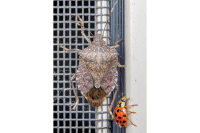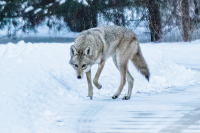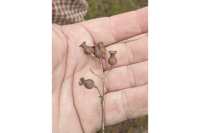Failure to communicate?
Well it seems there was one and I’m sure it could have been my fault. Smoky Mountain News reporter Holly Kays called me Wednesday morning — Oct. 12 — to ask me what I thought of Haywood County commissioners’ latest resolution regarding wilderness designation in the Pisgah and Nantahala national forests. I told her I didn’t know, as I hadn’t seen the resolution. I told her I had a copy on my computer but that I hadn’t looked at it.
You’re going the wrong way – not
When you’re out chasing fall migrants and you either have a good internal compass or you’re somewhere it’s pretty easy to orient yourself to the cardinal directions, like the Blue Ridge Parkway, it’s not unusual to find mixed flocks of migrants moving in what appears, intuitively, to be a “wrong” direction. You may find groups of birds moving north, or east, or west rather than the general southwest route we expect here in the mountains of Western North Carolina. These early morning flights — usually just after sunrise — are called “redetermined” flights.
Big and wild
Big and wild can’t be big and wild if your mind and heart are small.
A “real” public meeting — as in announced and on the docket — took place in Asheville on Sept. 20 as Buncombe County Commissioners listened to pros and cons regarding the proposed Craggies Wilderness Area and Big Ivy. The result was a resounding success for the local “Friends of Big Ivy” group and a diverse assemblage of environmental groups and local citizens who love “their” wilderness.
Must have been an omen
When I checked my email Friday morning (9/9), I had a message from Chris Kelly, mountain wildlife diversity biologist with North Carolina Natural Resources Commission. Kelly helps coordinate an annual nightjar (birds of the family Caprimulgidae like Chuck-will’s-widow and whip-poor-will) survey across the mountains of North Carolina for the national Nightjar Survey Network. The email was an update for those who volunteer for the nightjar survey but it started out with a note that, “It is Common Nighthawk migration time!”
Can’t see the forest for the webs
From what I gather from Facebook and overhear in the checkout line, the view I encounter every morning on my daily trip from Balsam Gap to Tuscola High School is pretty much standard across Western North Carolina and, according to a Google search across much of the country – places like Michigan, Pennsylvania, Maryland, Missouri, and others. That view is one of roadside trees full of what looks like dirty gray-brown plastic bags.
Ma Nature doesn’t see things the way we do
The red-cockaded woodpecker (RCWO) is a small – cardinal-sized – woodpecker native to eastern pine forests. It once ranged from New Jersey southward to Florida and westward to eastern Texas and portions of Oklahoma and Missouri. The RCWO is dependant upon old growth pine forests, especially longleaf pine.
A real can of DNA worms
A new whole-genome (the entire genetic makeup) study published in Science Advances on July 27 is giving the already muddied waters of wolf-coyote ancestry another stir.
Wading through nostalgia
 Give a Loosiana boy a reason to don his hip boots and strap on a headlight and you’ve got a happy camper. I recently got that opportunity through a contract with the Forest Service to do a salamander survey on three streams in the Cheoah District of the Nantahala National Forest. The three small headwater streams were Wolf Laurel, Sand Creek and Whiggs Branch.
Give a Loosiana boy a reason to don his hip boots and strap on a headlight and you’ve got a happy camper. I recently got that opportunity through a contract with the Forest Service to do a salamander survey on three streams in the Cheoah District of the Nantahala National Forest. The three small headwater streams were Wolf Laurel, Sand Creek and Whiggs Branch.
Combination science lab and amusement park
 Weightless for two seconds is not a moonwalk but at the top of the Space Shot at Huntsville, Alabama’s (Rocket City) U.S. Space & Rocket Center, it does give your brain a split second to wonder — am I going up or down?
Weightless for two seconds is not a moonwalk but at the top of the Space Shot at Huntsville, Alabama’s (Rocket City) U.S. Space & Rocket Center, it does give your brain a split second to wonder — am I going up or down?
Peregrines once again at Devil’s Courthouse
 A couple of Saturday’s ago Bob Olthoff and I made a quick trip up the Blue Ridge Parkway. We were going up to Black Balsam to look for yellow-rumped warblers. Yellow-rumps are regular visitors to Western North Carolina during the winter but generally pack their bags and head back to New England and/or Canada for nesting season. Occasionally nesting yellow-rumps can be found at higher elevations in the mountains of North Carolina.
A couple of Saturday’s ago Bob Olthoff and I made a quick trip up the Blue Ridge Parkway. We were going up to Black Balsam to look for yellow-rumped warblers. Yellow-rumps are regular visitors to Western North Carolina during the winter but generally pack their bags and head back to New England and/or Canada for nesting season. Occasionally nesting yellow-rumps can be found at higher elevations in the mountains of North Carolina.









